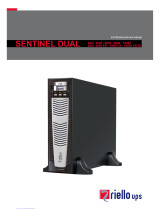
10-40 kVA 400 V & 10-20 kVA 208 V 3:3,10-30 kVA 400 V 3:1
Table of Contents
Important Safety Instructions — SAVE THESE
INSTRUCTIONS.........................................................................................5
Electromagnetic Compatibility .....................................................................6
Safety Precautions .....................................................................................6
Overview ......................................................................................................7
User Interface ............................................................................................7
Display Interface...................................................................................9
Menu Tree............................................................................................9
Overview of Single UPS ............................................................................ 11
Overview of 1+1 Redundant Parallel System with Common Battery
Bank........................................................................................................12
Overview of Parallel System......................................................................13
Location of Breakers - 400 V Systems ........................................................16
Location of Breakers - 208 V Systems ........................................................20
Operation Modes ......................................................................................22
Operation Procedures..............................................................................26
Initial Start-Up of the UPS Using the Wizard – Only Applicable to Single
UPSs with Internal Batteries ......................................................................26
Start-Up Checklist – Only Applicable to Single UPSs with Internal
Batteries ............................................................................................27
Start Up a Single UPS in Normal Mode ......................................................27
Transfer a Single UPS from Normal Mode to Static Bypass Mode.................29
Transfer a Single UPS from Static Bypass Mode to Normal Mode.................30
Transfer a Single UPS from Normal Mode to Maintenance Bypass
Mode.......................................................................................................30
Transfer a Single UPS from Maintenance Bypass Mode to Normal
Mode.......................................................................................................31
Transfer a Parallel System from Normal Mode to Maintenance Bypass
Mode.......................................................................................................32
Transfer a Parallel System from Maintenance Bypass Mode to Normal
Mode.......................................................................................................33
Isolate a Single UPS from the Parallel System ............................................34
Start Up and Add a UPS to a Running Parallel System ................................35
Configuration .............................................................................................37
Register Your Easy UPS 3S ......................................................................37
Set the Display Language .........................................................................37
Set the Date and Time ..............................................................................38
Set the UPS Settings ................................................................................38
Set the Battery Settings.............................................................................39
Recommended Settings for 400 V UPSs with Internal Batteries and
Modular Battery Cabinets ....................................................................40
Recommended Settings for 208 V UPSs with Internal Batteries and
Modular Battery Cabinets ....................................................................42
Set the Life Cycle Monitoring .....................................................................44
Settings ...................................................................................................45
Tests............................................................................................................47
Perform a Battery Maintenance Test ..........................................................47
990-91079G-001 3




















